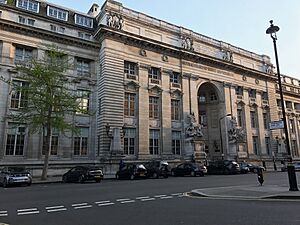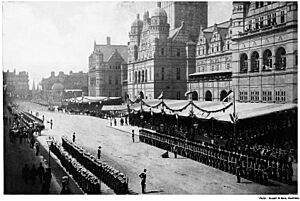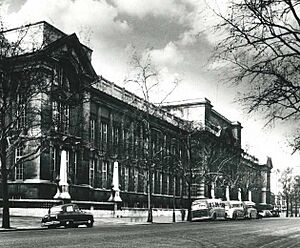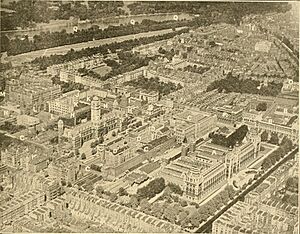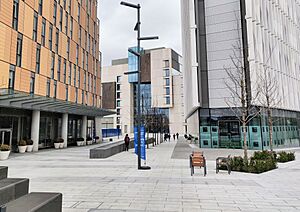History of Imperial College London facts for kids
Imperial College London is a famous university in London, England. Its story began a long time ago, even before it was officially called Imperial College. Some of its oldest parts, like medical schools, started way back in 1823. The main college was officially created in 1907. It brought together several important science and engineering schools in South Kensington. For many years, it was part of the University of London. But in 2007, it became an independent university. Imperial College has always been a key place for science, engineering, medicine, and business studies in the UK.
Contents
How Imperial College Started
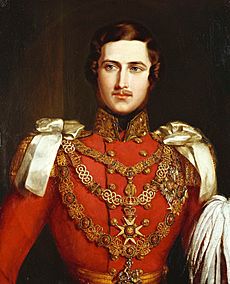
Imperial College grew from several older schools. The very first one was the Royal College of Chemistry. It opened in 1845 in Hanover Square, London. Prince Albert and the government supported it.
Later, in 1853, the Royal College of Chemistry joined a new school called the Government School of Mines. This school was for mining and applied science. It was renamed the Royal School of Mines ten years later.
Imperial's medical schools have a long history too. The oldest one started in 1823. It was a teaching facility at the West London Infirmary. This later became the Charing Cross Hospital Medical School. Another medical school began in 1834 at Westminster Hospital. And in 1854, the St Mary's Hospital Medical School was set up in Paddington.
The Great Exhibition's Legacy
In 1851, there was a huge event in London called the Great Exhibition. It showed off amazing inventions and art from around the world. Prince Albert decided that the money made from this exhibition should be used for public education.
This led to the creation of a special area in South Kensington. Over the next few years, famous museums opened there. These included the Victoria and Albert Museum, the Science Museum, and the Natural History Museum. The Imperial Institute also opened in 1888.
New buildings were also made for the science colleges. The Royal College of Chemistry and the Royal School of Mines moved to South Kensington in the 1870s.
In 1881, the Normal School of Science was started. It taught natural sciences and agriculture. This school was renamed the Royal College of Science in 1890. These early schools couldn't give out university degrees. Instead, students earned special certificates called "associateships."
Another important school was the Central Institution of the City and Guilds of London Institute. It opened in 1885. This school focused on technical education. It was later called the Central Technical College. In 1900, it became part of the University of London.
Imperial College in the 20th Century
At the start of the 1900s, people in Britain worried. They thought the country was falling behind Germany in science and technology. They wanted to create a big, advanced technical university in London.
In 1904, a special committee was set up. It looked into combining the Royal College of Science and the Royal School of Mines. They also wanted the Central Technical College to join.
On July 8, 1907, King Edward VII officially created the Imperial College of Science and Technology. This new college brought together the Royal School of Mines and the Royal College of Science. The Central Technical College joined in 1910, becoming the City and Guilds College. Imperial College also became a part of the University of London in 1908. The main campus was built next to the Imperial Institute.
Even though Imperial was part of the University of London, its three original colleges still gave out their own certificates. These were the ARCS, ARSM, and ACGI. In 1912, a new postgraduate certificate, the Diploma of Imperial College (DIC), was added.
Soon, people wanted Imperial to become a full university. They wanted it to give its own degrees, separate from the University of London. Students were even going to America to get degrees. While Imperial didn't become fully independent then, the University of London changed its rules in 1925. This allowed Imperial students to earn a Bachelor of Science (BSc) degree.
In 1945, King George VI and Queen Elizabeth visited Imperial. They celebrated 100 years since the Royal College of Chemistry was founded. This visit led to "Commemoration Day," which is now the university's main graduation ceremony every October. Imperial also got a biology research station at Silwood Park in 1947.
Growing After the War
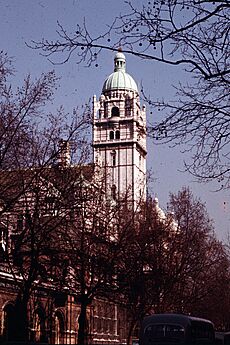
After World War II, Britain again worried about falling behind in science. This time, they looked at the United States. There was an idea to create a "British MIT" (like the famous Massachusetts Institute of Technology). Many scientists and politicians supported this.
In 1952, the government decided to expand Imperial College. It would almost double in size, from 1,650 to 3,000 students. It would become a top technology institution, but it would stay part of the University of London.
This expansion meant many new buildings. The Hill building opened in 1957, and the Physics building in 1960. The East Quadrangle was finished between 1959 and 1965. Some older buildings, like the City and Guilds College, were taken down. The Imperial Institute building was also mostly demolished, but its central tower, now called the Queen's Tower, was saved.
New biochemistry labs were built in 1959. This helped bring famous scientists like Ernst Chain to Imperial. The Queen opened these new buildings in 1965.
In 1963, Imperial started a special partnership with the Indian Institute of Technology Delhi. Imperial helped train staff there. Also, a new department for the History of Science and Technology was created.
By the late 1960s, government money was harder to get. In 1969, Imperial asked for £2 million in donations. More than half of this money was for student housing. The goal was for students to live in college halls for at least one year.
New departments were also created. The Department of Management Science started in 1971. The Associated Studies Department, which taught foreign languages, began in 1972. In 1980, the Humanities Department was formed by combining Associated Studies and History of Science.
Imperial College of Science, Technology and Medicine
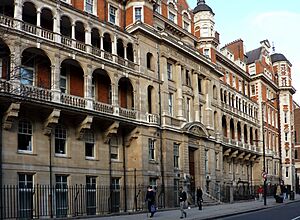
In 1988, Imperial College joined with St Mary's Hospital Medical School. This changed Imperial's official name to The Imperial College of Science, Technology and Medicine. St Mary's became a part of Imperial.
Imperial continued to grow in the 1990s. In 1995, it started its own publishing company, Imperial College Press. It also merged with the National Heart and Lung Institute in 1995. In 1997, it merged with several other medical schools. The Imperial College School of Medicine was officially created that same year.
In 2000, Imperial merged with the Kennedy Institute of Rheumatology. It also merged with Wye College, an agricultural college. Wye College later closed down.
Imperial College in the 21st Century
In 2001, Imperial College changed how it was organized. The older colleges that had joined Imperial became fully integrated. They lost their individual names. Instead, Imperial created a system of faculties. These included Engineering, Medicine, Life Sciences, and Physical Sciences. In 2005, Life Sciences and Physical Sciences merged to form the Faculty of Natural Sciences.
In 2002, there was an idea to merge Imperial with UCL. This would have created a huge university. But many professors, especially at UCL, were against it. They worried Imperial would take over. So, the merger plans were stopped a month later.
In 2003, Imperial College gained the power to award its own degrees. This meant it no longer needed the University of London to do it. The London Centre for Nanotechnology was also started that year, a joint project with UCL. In 2004, the Imperial College Business School opened. Queen Elizabeth II opened it herself.
On December 9, 2005, Imperial announced it would leave the University of London. Imperial became fully independent in July 2007. In 2008, the Centre for Advanced Structural Ceramics opened.
In 2011, Imperial joined with King's College London to create the UK Centre for Medical Research and Innovation. This center was later renamed the Francis Crick Institute. It opened in 2016 and is the largest biomedical lab in Europe.
In 2013, the Brevan Howard Centre for Financial Analysis was built. It researches money and risk. In 2014, the Dyson School of Design Engineering opened. This was thanks to a large donation from James Dyson. It offers courses in design engineering.
Imperial College started moving into its new White City campus in 2016. The Innovation Hub opened there first. Then, in 2018, the Molecular Sciences Research Hub opened for the Chemistry Department.
See also
- Albertopolis
- Commonwealth Institute
- University of London


